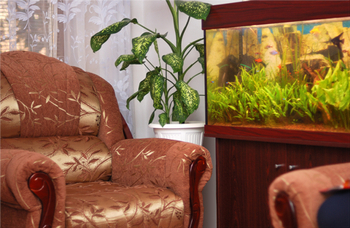

One of the struggles in our home is the issue of how many fish tanks my wife will allow my kids and me to have and where we are allowed to put them.
The first obstacle to finding the ideal room location is heat and light. If you locate an aquarium where it gets too much direct sunlight, algae can grow out of control.
We have air conditioning and heat through vents at the bottom of the wall in many rooms, so we don't want our tanks there, either. The heat or cold may affect tank temperature unfavorably. And the tank stand might block the flow of cold or warm air to the room we want to cool or heat.
Availability of electric outlets is also a factor in aquarium location. Aquariums often have equipment requiring at least three electrical outlets - typically the filter, heater, and tank light. Add two more outlets if you have a separate under-gravel filter and an aerator pump.
Next, choose rooms that people actually populate. We have an extra room over our garage that serves multiple purposes including filing space for my home business and a place to put our air hockey table.
But we don't spend a lot of time there, so the viewing time for an aquarium in that room would be minimal. We also don't use our dining room much except when we have company, so a tank in that room would get little viewing.
Put your tanks in rooms where people spend a lot of time: living room, family room, and kids' bedrooms. (We don't spend much time in our bedroom aside from sleeping, but teens live in their rooms, so a bedroom tank is ideal.)
Our 92-gallon corner tank is in our living room. To maximize my enjoyment, I have a comfortable chair in the room. I turn the chair to face the tank during feeding time. After dropping in flakes or pellets, I sit back in the chair and spend a few peaceful minutes watching the fish eat.
I also have a desk chair in front of the table in my son's room where we keep Zoidberg, our teacup stingray, in a 40-gallone tank on a table. I always sit in the chair to watch Zoidberg suck up and munch the live black worms he eats.
Since tanks are normally kept against a wall, you need a room with sufficient free wall space. If you have a lot of bookcases, couches, and electronics (TVs, game systems), finding free space for your fish tank can be a challenge.
My wife objects that fish tanks don't go with the décor of certain rooms. In a formal or semi-formal room, you can't go wrong with an aquarium containing a variety of small community tropical fish. A goldfish tank also fits any room.
If you have a tank that is more "earthy" or nature-oriented - a terrarium with salamanders, lizards, turtles, large cichlids, an arawana or other big lone fish, a tank with lake or pond fish in a natural setting - it may be better suited for a family room, playroom, or kid's bedroom.
A betta or goldfish in a bowl, or a few small fish in a 5-gallon or 10-gallon tank, can fit nearly anywhere in any home. Plastic aquariums of 5 gallons and smaller, as well as bowls, can easily be picked up and moved to another room if it interferes with use of the room in which it is now located.
With a tank size of 20 gallons or larger, the tank can tend to dominate the room visually, and so the tank specimens - and even the decorations - should be chosen to compliment rather than clash with the rooms décor and function (e.g., a piranha snacking on goldfish isn't a good choice for the dining room, kitchen, or even the living room in which you entertain guests).
One other consideration is sound: for bedrooms as well as rooms where you want to relax quietly, watch TV, or hold conversations, tanks with noisy filtration systems can interfere with your enjoyment of the room. The choice is to locate the tank in another room or replace the filtration system with a quieter model.